by Romina Ciulli and Carole Dazzi
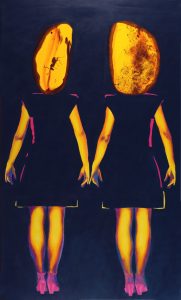
Savina Capecci’s artistic universe is made up of bright and powerful colours, and tells stories related to contemporary society through an ironic, if not downright unreal, perspective. Indeed, in her work the protagonists seem to live a detached existence within an imaginary that always remains suspended between two dimensions: the experiential and the natural.
A space in which the meaning of living is investigated in its most ambiguous and disorienting aspects, searching for an emotional reaction capable of generating not only a new balance between man and nature, but above all a new yearning for hope. The man-woman relationship, the incommunicability, duality, feelings of expectation, the concepts of ambiguity and harmony, are all themes that can be found in her works, from The Alchemist’s Garden (2020), to The Noisy Silence of The Untold (2020), to What If We Were The Ocean And Not The Waves? and others. Let’s talk about it with the artist.
The Alchemists’ Garden (2020) is a work characterized by a recurring and dualistic ambiguity. The whole composition is played on a reassuring appearance, which, on the contrary, finds its emotional “upheaval” in the alchemical concept of transmutability: two similar but dissimilar women, a flowery dress with a geometric cuff, and an expanse of flowers that hides signals of danger. Can you tell us how this painting was born?
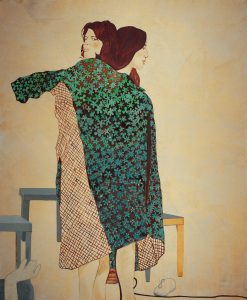
This work was born from a sketch made while I was in residency in Salzburg attending a masterclass in alchemical painting at the International Summer Academy, during a pause and pose change of the models. The work subsequently took shape in my studio until it gave the title to my solo exhibition “The Alchemists Garden” held in autumn 2020 at the Silvia Zenari Civic Museum of Natural History in Pordenone curated by Fulvio Dell Agnese. This title has become a message of hope so that a new harmony between nature and humanity can blossom. Each of my paintings invites us to a second reading, to a second level of interpretation: for example, the flowery dress, if you look at it closely, contains some tripetal flowers, signal of a radioactive danger.
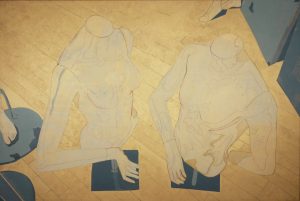
The issue of incommunicability between man and woman is emphasized in “The Noisy Silence of The Untold” (2020). Here two acephalous mannequins caught in a silent conversation, or rather in a non-dialogue, devoid of words, which disturbs and unsettles the viewer for its elusiveness. How did you make this difficulty in communicating stylistically?
The arms pose, the wrists flex, but the two acephalous actors can’t say nothing. Their absence of dialogue is emphasized by the photographic cut from above, with the pedestals that mark the limits of their immobility, like pawns, out of any real communication. And the gold background is created by the diagonal lines of the floor, on which the forms remain both fixed and suspended.
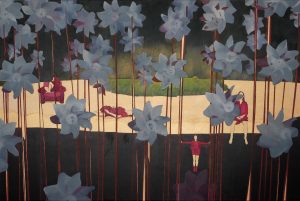
Another recurring theme of your research is that of waiting. In “What If We Were The Ocean And Not The Waves” (2020), for example, or in “Total Eclipse Of The Mind” (2019), up to “Waiting For” (2017), the viewer’s gaze is immersed in scenes of apparent normality, which underlie yearnings for transformation. It is precisely a status of waiting which, however, remains suspended between hope and instability. Do you believe that this feeling also affects your creative process?

It certainly has some influence on my creative process, after all in every work of an artist there is a piece of her soul, a moment of her life and of the collective one.
In Total Sale (2019), the relationship between art and consumer society is investigated. Can you tell us about it?
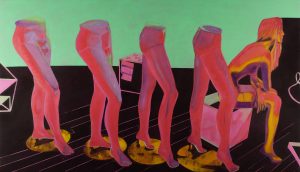
This work is inspired by a photo I took during the total sale of a large clothing store, during which the mannequins and furniture were also put up for sale. And I imagined this scene: five mannequins remained in the shop window. Four pairs of legs remained fixed in the pose of what can be now considered a useless fashion show. Even if the colors saturated, still seem impregnated with the glare of the spotlights, the paying public is no longer there. The collection is “sold out” and, on their amber pedestals, the chrysalis of men and women start to become, in the perspective of a “total sale”, the ultimate marketable object. Is it just the image of a body being sold off? Or is art itself making compromises with the society of which it is an expression? Maybe the answer is known by the only full-figure mannequin, who, with a profoundly human disenchantment directs the glance towards a far horizon.
The duality in your works represents an aspect that is linked not only to the concept of ambiguity, but also to the representation of values with no longer definable boundaries, mostly personified by female figures. As in Imperfect Like Pure Amber (2017), where two women with metaphysical contours evoke unusual and enigmatic reflections. How does the pictorial image grasp the complexity of reality?
In the work “Imperfect like pure Amber” the image represents a double: two women who touch each other’s hand with a veil of Eros, or the same woman who hides inside an identity conflict. Like in a piece of amber, in which impurities give an added value, concepts of perfection and purity become ambiguous, and perhaps are no longer enough to define a horizon of life.
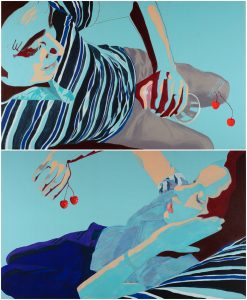
In the series of paintings entitled “The Transgenic Attack” (2014-2017) you explore the relationship between human beings and nature. Can you tell us about it?
In the painting project “The Transgenic Attack”, which deals with the theme of genetically modified food GMO, I imagine with apparent irony the moment when Nature, humiliated and modified by humans, decides to take its revenge by taking possession of the bodies of a multitude of human beings through some sort of genetic mutation thus creating transgenic hybrids.
Ambiguity returns again in “Fragile Balance” (2020-21), where violence against women is expressed through the tension created by a pink scarf that wraps the two partners. How was this work born?
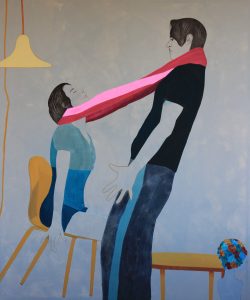
I have worked on this topic in some different paintings. This work in particular was created during the pandemic. The lockdown is a high price that some women had to pay, forced at home with a violent partner, which has mainly affected their physical and psychological balance. On the canvas, the ambiguity between care and violence lies in the tension of a fluorescent pink scarf that wraps the partners, and in the imminence of a hug or a probable slap. This work was selected for an exhibition entitled “See you tomorrow” which was held in Venice in 2021 at Palazzo Dona Brusa (curated by a.topos). And subsequently selected for the exhibition project “Kunst trotz gewalt” (Art defies violence) in Salzburg, Austria.
We would like you to tell us about your contribution to the exhibition “Kunst trotz gewalt” in Salzburg.
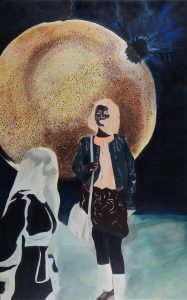
I am pleased to have contributed with my paintings “Fragile Balance” and “Total Sale” to the exhibion project “Kunst trotzt gewalt” 2021 (Art Defies Violence) at gallery Fotohof in Salzburg, Austria, curated by Hildegund Amanshauser, Andrea Kopranovic and Martina Pohn and promoted by Frauennotruf Salzburg and Gendup – Center for Gender Studies and the Advancement of Women. Happy to be able to participate at the closing event on 7 October 2022 with the projection large scale of the artworks (painting, photos, video and text) of the 23 international artists selected by the jury.
Can you tell us about your future projects?
Among my upcoming projects there is the transfer to a larger studio, which allows me to express on larger scale canvases. Another one is the organization of a personal exhibition with the body of works created between 2020 and 2022, which are part of a project entitled “Dancing with uncertainties“. Last but not least, I would like to start a new collaboration with a gallery that supports, promotes and actively shares my work, because sharing is important for me.